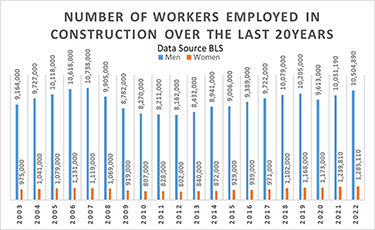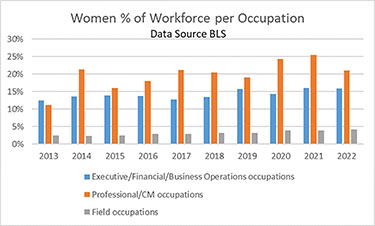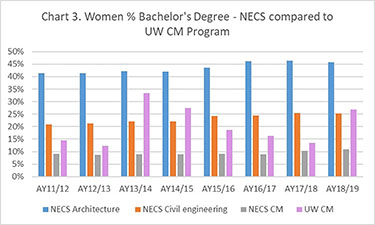|
Subscribe / Renew |
|
|
Contact Us |
|
| ► Subscribe to our Free Weekly Newsletter | |
| home | Welcome, sign in or click here to subscribe. | login |
Construction
| |
 |
March 6, 2023
Women in construction management: charting a path forward
University of Washington

Septelka
|

Wu
|
As the industry celebrates Women in Construction Week, it’s a great time for us to reflect on the progress that has been made to date and look ahead to what needs to be done to continue advancing the representation and participation of women in our industry.
STATUS OF WOMEN DIVERSITY IN THE CONSTRUCTION INDUSTRY
According to the U.S. Bureau of Labor Statistics (BLS) for 2022, women can cheer since they currently have 1.29 million construction jobs, up 3.65% from 2021. This could seem positive at first glance — more women are employed in the construction sector. Yet the most important question that needs to be answered is: While the overall number is growing, is the traditionally male-dominated industry embracing more diversity? The BLS data for a 20-year period was then examined, and we discovered that the overall gain was only 1.28% since 2003, and only 10.9% of construction workers were women in 2022. If we continue on our current course, we wouldn’t reach 2 women to 10 men until 2055.
IS THERE A PAY DISPARITY?
When reviewing the 2022 yearly median weekly earnings for the construction sector, we compared the women median pay to the median pay for men and found the pay disparity was 16%, but when compared to 2021 the disparity had decreased by 4%, thus trending in the right direction.
WHERE ARE WOMEN WORKING?
Let’s go one step further and break out the construction sector into occupation categories to examine what type of work women are performing in the BLS construction sector. Out of the total women employed in the construction sector the percentage per occupation category is as follows: 11% for executive, financial and business operations occupation; 14% for professional occupations; 12% for sales occupations; 57% for office occupations; 3% for field construction occupations; and 3% for other service such as transportation/maintenance occupations. So, most women in the construction sector are employed in office jobs with the least working in the field.
But what is the overall diversity for each occupation category in the construction sector? Let’s take a look at three: executive, financial, and business operations occupations is 16%; professional occupations is 21%; and field construction occupations is 4.18%. Thus the management and professional occupations are more diverse than those working in the field construction occupations.
When we examined the three occupation categories over a 10-year period the diversity of the workforce gained by 128% in the executive, financial and business operations occupations, 188% in the professional occupations, and 175% in field construction occupations. The overall construction sector gain for all job categories was 120%. If we predict the diversity growth over the next decade, based on the diversity growth over the last decade, we would predict that in 2033 women would represent 20% in executive, financial and business operations occupations, 40% in the professional occupations, and 7% in field construction occupations.
WOMEN ARE MAKING GAINS IN PROFESSIONAL OCCUPATIONS
The potential gain from enhanced diversity is greatest in the professional construction occupations, which includes construction managers. Construction managers’ employment is expected to increase 8% between 2021 and 2031, faster than the average for all occupations, according to the 2021 BLS Occupation Outlook Handbook. The BLS also reported about 41,500 openings for construction managers each year, on average, over the decade. Many of those openings are expected to result from the need to replace workers who transfer to different occupations or exit the labor force, such as retirement, which will create additional employment opportunities for women.
Nationwide, there are a total of 478,500 male and female workers employed as construction mangers, of which 10,490 are employed in Washington state, with a mean annual wage of $116,800 in Seattle. With the expected employment growth, women in our region can enjoy excellent employment and salary opportunities as construction managers.
ARE UNIVERSITIES PROVIDING A PIPELINE OF WOMEN?
According to the BLS Handbook, construction managers normally require a bachelor’s degree. Nationally, there are now 123 approved programs offering bachelor’s degrees in construction management (CM) or construction engineering (CE). The Associated Schools of Construction and the two accreditation bodies ACCE and ABET do not compile or publish diversity data. Women made up just 9% of students enrolled in construction degree programs, according to the author’s research for her previous DJC article in 1999.
The National Center for Education Statistics’ (NCES) most recent report on degrees awarded for the academic year 2018/19 indicated that women made up 11% of bachelor’s degrees conferred in construction management or construction engineering — only a 1.1% overall increase since NCES started tracking CM degrees for the academic year 2011/12.
When compared to other programs within the built environment schools, the ratio of female students graduated from CM program is significantly lower. For example, the graduated women in civil engineering programs was 21%, while that of architecture programs was 41%. This shows that more needs to be done to encourage high school students to choose a career in construction management and to introduce freshmen to our CM programs before they declare a major.
Yet, the NCES data indicates that the master’s programs in CM are more diverse compared with the undergraduate programs — the female student ratio was 23% in academic year 2018/19. This suggests that more women are either entering the construction industry after completing undergraduate degrees in other disciplines or are working toward career development to senior management positions in the construction industry. Our analysis of the BLS data reveals that there will be plenty of opportunities and room for advancement for women working as construction executives, further breaking the glass ceiling for women.
We cannot confirm whether the NCES data accurately reflects the current status of women in our CM programs nationwide without surveying specific schools and universities. We can confirm that the University of Washington’s CM program is significantly better than the national average, with a women’s ratio of 17% among all graduates in the bachelor’s CM program and a ratio of 38% in the master’s CM program in academic year 2021/22. Women make up 44% of the primary faculty in the UW’s CM program, and 30% of the affiliates and instructors, which significantly contributes to a more diversified classroom, and establishes role models and mentors for the next generation.
MORE INCLUSIVE AND WELCOMING WORKPLACE
In conclusion, while there may be a variety of causes for the inequality observed, we can all agree that bringing more women into the construction industry would be advantageous. In addition to introducing more diverse viewpoints and enhancing problem-solving and creative abilities, it would help alleviate the existing labor deficit on construction projects. If our growth predictions for construction managers are accurate, we must examine how to increase the diversity of students at our universities in order to satisfy business demands for a more inclusive and welcoming workplace.
Darlene Septelka is an assistant teaching professor in the Department of Construction Management at the UW. Lingzi Wu is an assistant professor in the Department of Construction Management at the UW.
Other Stories:
- Breaking barriers: inspiring stories of women in construction
- Local NAWIC chapter holds events this week
- Women: The secret ingredient for taking the local construction industry to the next level
- Meet the women at Skanska building a more inclusive culture





